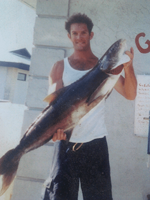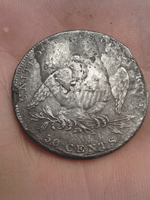Navigation
Install the app
How to install the app on iOS
Follow along with the video below to see how to install our site as a web app on your home screen.
Note: This feature may not be available in some browsers.
More options
You are using an out of date browser. It may not display this or other websites correctly.
You should upgrade or use an alternative browser.
You should upgrade or use an alternative browser.
Capped Bust half dollar!
- Thread starter GatorBoy
- Start date
WHADIFIND
Gold Member
Hey Gator, I was with you from the first post and my response. I knew that yeah it was possible to be a counterfeit but ONLY if they had gone to all the trouble of using silver to make it!!! LOL
Way back when I started I used to do a lot of water hunting. I KNOW that black/sand/oxide crust VERY well!
I might have piped up but the "experts" were doing soooooo well, I just figured I'd watch and see how much rope they needed. LOL
Great find! But, since I like coins, I'd rather not find them in saltwater.
HH!
Way back when I started I used to do a lot of water hunting. I KNOW that black/sand/oxide crust VERY well!
I might have piped up but the "experts" were doing soooooo well, I just figured I'd watch and see how much rope they needed. LOL
Great find! But, since I like coins, I'd rather not find them in saltwater.

HH!
hogge
Silver Member
- Mar 13, 2008
- 3,815
- 1,505
- 🥇 Banner finds
- 5
- Detector(s) used
- Teknetics T-2SE--Whites Prism IV
- Primary Interest:
- All Treasure Hunting
OH! I see......I guess the fishing reel was letting an awful lot of "drag" out before the hook was set.Hey Gator, I was with you from the first post and my response. I knew that yeah it was possible to be a counterfeit but ONLY if they had gone to all the trouble of using silver to make it!!! LOL
Way back when I started I used to do a lot of water hunting. I KNOW that black/sand/oxide crust VERY well!
I might have piped up but the "experts" were doing soooooo well, I just figured I'd watch and see how much rope they needed. LOL
Great find! But, since I like coins, I'd rather not find them in saltwater.
HH!

WHADIFIND
Gold Member
OH NO! Don't be pulling on the one who's doing the leg pullage! LOLOH! I see......I guess the fishing reel was letting an awful lot of "drag" out before the hook was set.

It is why I don't water hunt much anymore though. Coins are my thing.
HH!
- Jan 27, 2009
- 18,792
- 11,909
- 🥇 Banner finds
- 1
- Detector(s) used
- Tesoro Conquistador freq shift
Fisher F75
Garrett AT-Pro
Garet carrot
Neodymium magnets
5' Probe
- Primary Interest:
- All Treasure Hunting
Treasure is where you find it. I think everyone was just trying to help and nobody has any hard feelings. Nice fish.
John_Deere
Hero Member
- Mar 7, 2013
- 600
- 193
- Detector(s) used
- Personal: Bounty Hunter Gold Digger
Family: White's Coinmaster
- Primary Interest:
- All Treasure Hunting
Sweet find! Congrats and HH!
recondigger
Bronze Member
- Jul 12, 2012
- 1,223
- 900
- 🥇 Banner finds
- 1
- Detector(s) used
- garrett at4 beach hunter, bounty hunter,CZ-5,CZ-7, Minelab EXP SE, Garrett ACE-150, E-Trac, CTX 3030
- Primary Interest:
- All Treasure Hunting
Wow that almost looks like its made out of silver! ... Just kidding I really like it once again good going
Scouts out!
Scouts out!
lonegunlawyer
Greenie
Real or contemporary counterfeit, it's still a cool find.
GatorBoy
Gold Member
- May 28, 2012
- 14,716
- 6,156
- Primary Interest:
- All Treasure Hunting
- Thread starter
- #72
There's an excellent chance it's a contemporary (meaning "from the 19th century era") counterfeit. It just does not look like it's made of silver. What it could be is German Silver, an alloy of copper/nickel/zinc that might corrode this way. Many of these counterfeit coins circulated in the 1840s-1860s, and I suspect a lot of them were chucked into a local river when the owner discovered they were bogus.
Years later I end up back here downloading the images to share with someone else just want to reiterate this was absolutely not a counterfeit it was Second Seminole War payroll it was a saltwater find
RelicMaster777
Full Member
- Jul 8, 2018
- 247
- 1,033
- Detector(s) used
- CTX 3030
Equinox 800
Equinox600
Makro Multi Kruzer
Garret ATpro
Garret ATX
- Primary Interest:
- All Treasure Hunting
oh yeah that salt water and sand combo really does a job on silver coins. I'm surprised that thing came out even recognizable. Here is some silver I pulled out of my beach last week and they were only buried 50 to 70 years
Standing Liberty Q
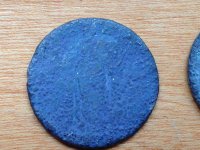
Washington Q
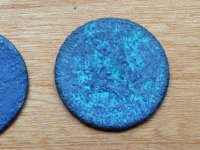
Silver dimes
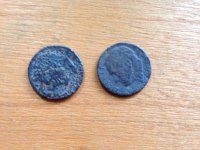
Silver Rings
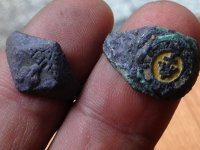
Anyway a very cool find Capped Bust Half....Congrats
Standing Liberty Q

Washington Q

Silver dimes

Silver Rings

Anyway a very cool find Capped Bust Half....Congrats
sliverslave
Full Member
Nice
Top Member Reactions
-
 3461
3461 -
 2058
2058 -
 1968
1968 -
 1164
1164 -
 1109
1109 -
 926
926 -
 831
831 -
 810
810 -
 807
807 -
 789
789 -
 747
747 -
 529
529 -
 480
480 -
 475
475 -
 445
445 -
 423
423 -
E
416
-
 416
416 -
 416
416 -
 392
392
Users who are viewing this thread
Total: 3 (members: 0, guests: 3)
Latest Discussions
-
-
-
They want half of the treasure because they are the reason for knowing the place.
- Latest: Treasure_Hunter
-
-



